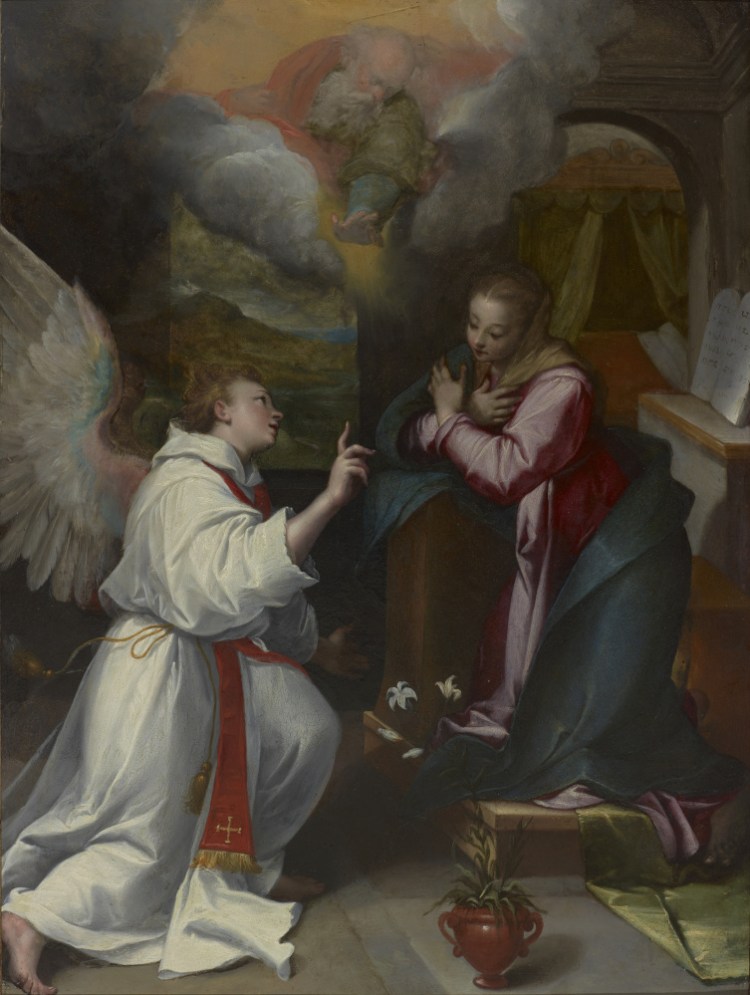Elise Ansel’s “Distant Mirrors” is a small show in which the painter presents a series of drawings and paintings that comprise a sort of visual investigation of Denys Calvaert’s “Annunciation” (ca. 1595) owned by the Bowdoin College Museum of Art.
It is a gorgeous and engaging exhibition of a scale typical of most gallery shows, that naturally divides into three parts. The first part is Calvaert’s “Annunciation.” Next is a suite of Ansel’s scratchy, jumpy and descriptive short-hand style drawings. The ultimate component is Ansel’s deliriously luscious oil versions of the Calvaert.
The show is contained in a single room, allowing the viewer to look from any of the works back to the original model. In this sense, as well, the Calvaert maintains a powerful visual gravity. The sophistication of its structure, composition and iconography come more and more into focus as the viewer’s eye moves between Ansel’s images and her model. This is an important effect, because the contemporary audience is not used to such deeply involved viewing of complex narrative painting.
The annunciation may be the most painted scene in the history of Western culture. It depicts Gabriel’s announcing to Mary that she will be the mother of Jesus. It is a hefty and humbling moment during which Mary is aware of both lofty honor and extreme tragedy. As such a common theme, the iconography of the scene is rich and extremely well-known. Everything is extraordinarily well-scripted: symbolic objects such as flowers, Mary’s pose and outfit, the marriage bed, the direction of the angel’s entrance, Gabriel’s gesture and garb, and so on. Because the scene has been painted so often, it cannot be seen without considering its relationships to the painterly cannon.
Michelangelo looms particularly large, but almost every detail bears a reference. There is Fra Angelico in Gabriel, Leonardo in Mary’s pose, Michelangelo in her drapery, a specific Church order in Gabriel’s costume, and the classical art of rhetoric of their hands, which create a supercharged box at the center of the composition.
While the Calvaert pushes itself back into a rich cultural history, it also presents itself as a powerful devotional object, a common type of religious tool (which this copper-plate painting was, for someone). For Christians, this is a sacred object.
But what is it for Ansel? Her accompanying statement and catalog essay by Hanétha Vété-Congolo, Bowdoin associate professor of romance languages and literatures, would have us believe that it is a sort of semiotic encyclopedia overflowing with philosophical unravelings and gender assumption counterstrikes. And yet Ansel’s paintings are gorgeously engaged with the Calvaert. Her responses feel purely visual as though she is encountering the painting almost solely in formalist terms – its composition and visual structures. (Our instamatic formalism is very different from the Italian “composizione” which encompassed the unfurling of a painting’s narrative structure in time.)
In fact, it is overwhelmingly clear that Ansel’s primary goal is to reprise Calvaert’s composition in her own painterly language. There is worship at play, but it is the adoration of one painter for the work of another, as well as their shared language.
When I first described these works, I said, “It feels like Ansel painted them with her tongue.” Ansel obviously loves paint, and paint seems to go out of its way to show that the feeling is mutual.
Ansel’s works are compositional copies painted with the thick, sometimes loaded and very wet brush we associate with the Abstract Expressionists. She follows a contemporary vein of indulgently brushy and economic rendering. The colors are rich, saturated, contrasty and decisively quick. Ansel can handle a brush.
This is why it’s a perfect show for coastal Maine: The lusciously economic rendering of well-known genre scenes (i.e., landscape) is our vernacular standard. If you like brushwork, you will be hard-pressed not to enjoy this show.
This brushy bravura has long been the calling card of show-offy masculine painting in America, from de Kooning and his testosterone-fueled posse and on. So it’s a bit ironic that Vété-Congolo’s essay enthrones Ansel’s female voice in “the new woman’s lens.” To be sure, this is a worthy conversation, but Vété-Congolo doesn’t have the space to connect the here-and-now indulgence of Ansel’s work (its clear vehicle for success) and the complex history of the subject to a theory-primed minefield of dropped names. It’s like Ansel has designed a bicycle and Vété-Congolo wants to give her credit for inventing the wheel.
Calvaert’s painting is already a form of ekphrasis – the classical Greek term for one art form about another (e.g., a poem about a painting). And Mary was the very model for the average Christian’s interaction with God, a pious, but otherwise average person through whom God changes the future for the better. Hers is the basic Christian story of faith, mission and sacrifice. And during the Renaissance, Mary had come to be so important that the Church saw her popularity as a threat to Christ. It is an academic mistake to assume the rational, dominating male gaze wholly owns this particular scene.
But despite what is written in Bowdoin’s handsome catalog, it’s apparent Ansel gets it. She seems to channel Calvaert’s reverence for the painters who came before him. Whatever patriarchal potions poison the tides on which the codes of beauty ebb and flow, Ansel is willing to luxuriate in the powerful potential of aesthetic culture. Her final paintings from the series even turn the composition upside down, so she undoubtedly leaves the conversational door open, but Ansel is an engaged viewer. She clearly loves paint, and when you visit “Distant Mirrors,” it’s hard not to love it, too.
Freelance writer Daniel Kany is an art historian who lives in Cumberland. He can be contacted at:
dankany@gmail.com
Send questions/comments to the editors.




Comments are no longer available on this story